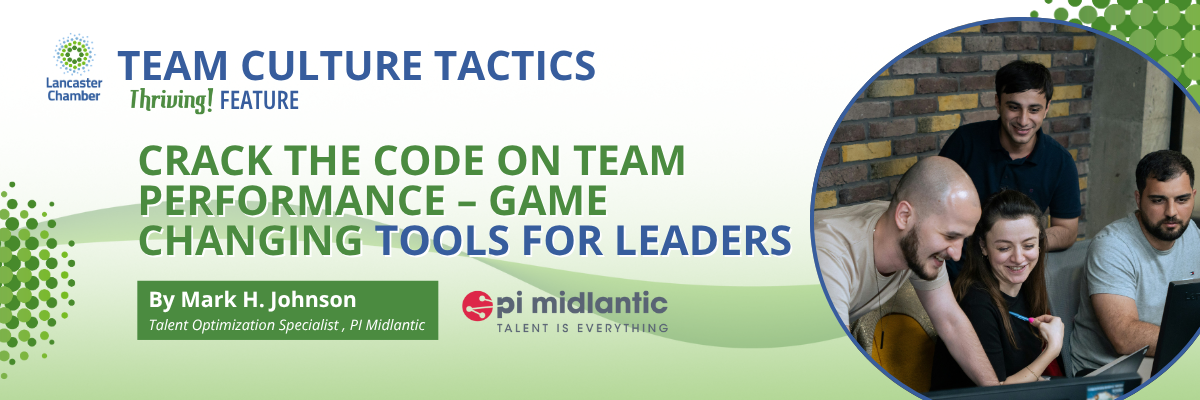By Mark H. Johnson, Talent Optimization Specialist at PI Midlantic
A Team Culture Tactics feature piece from our Fall 2025 issue of the Lancaster Thriving Publication
In today’s workplaces, strong teams are the foundation of business success. But building those teams requires more than simply placing talented people together. Leaders need tools that reveal not just what employees can do, but how they prefer to work, communicate, and grow.
What if you could predict how a team will perform?
The use of assessment tools gives leaders invaluable, predictive data on the drives, needs and behaviors of employees. Popular assessment tools include DISC for understanding behavioral styles and communication, Clifton Strengths Finder for identifying workplace strengths, and the Caliper Profile for predictive insights into job performance.
This article describes another widely used tool, The Predictive Index (PI). PI is a behavioral and cognitive assessment that helps businesses understand individuals at a deeper level—unlocking insights that strengthen collaboration, improve engagement, and ultimately, drive performance.
Understanding the Predictive Index
The Predictive Index is designed to measure two critical areas: behavior and cognition. Behavioral assessments highlight how people naturally prefer to communicate, make decisions, and approach work. Cognitive assessments reveal how quickly individuals process information and solve problems. Together, these insights give leaders a powerful lens into aligning employees with the right roles and creating environments where they can thrive.
How the Predictive Index Strengthens Teams
1. Better Hiring and Role Alignment
Hiring becomes more effective when roles are matched with candidates’ natural strengths. Using PI, businesses can identify whether an applicant’s behavioral drives align with the job requirements, reducing misalignment and preventing costly turnover.
2. Improved Communication and Collaboration
Miscommunication often stems from differing work styles. PI helps teams identify these differences upfront. For instance, a highly detail-oriented employee and a fast-paced collaborator may have friction unless they understand each other’s styles. PI provides a shared language to bridge those gaps.
3. Stronger Leadership and Management
Managers are most effective when they adapt their approach to individual team members. With PI, leaders can identify what motivates or demotivates employees, giving them the ability to coach in ways that feel natural, supportive, and empowering.
4. Higher Engagement and Retention
Employees feel engaged when their work matches their strengths and motivators. By integrating PI into development discussions, teams can create growth paths that honor everyone’s drives, boosting satisfaction and retention.
Actionable Tips for Using PI
Start with Leadership Buy-In: Have leaders and managers take the assessment first, then share the findings openly. This models transparency and positions PI as a team-strengthening, not evaluative, tool.
Incorporate PI in Hiring and Onboarding: Use PI benchmarks to craft accurate job descriptions and ensure a strong fit. During onboarding, share PI profiles within the team so new hires feel understood from day one.
Facilitate Team Workshops: Map out the team’s collective PI results to highlight both strengths and blind spots. Discuss how different work styles complement one another.
Adapt Management Styles: Use results to tailor recognition, communication, and task delegation. For example, some employees thrive with autonomy, while others perform best with frequent feedback.
Revisit Regularly: Don’t treat PI as a one-time tool. Revisit insights during team reviews, planning sessions, and development conversations to keep the learning alive.
Next Steps for Businesses
Where to start? Businesses interested in PI should start with a few key executives taking the PI assessment, which takes 10 minutes to complete. The author can provide a complimentary assessment and review of the results. Walk away with some insights into creating efficiencies in recruiting, performance management and leadership development. Effective PI adaptation results in lower turnover, higher employee engagement, less time spent on people challenges, and improved profitability.
About the Author
Mark Johnson is a certified PI specialist. His PI clients include manufacturers, financial companies, transportation companies and non-profits. His company, PI Midlantic, is the largest Predictive Index partner in the world. He has an MBA from the University of Virginia and an BA from Boston University. He can be reached at mjohnson@pimidlantic.com or on LinkedIn at linkedin.com/in/mhjohnson. For more information on PI Midlantic, visit www.pimidlantic.com .
not secure


